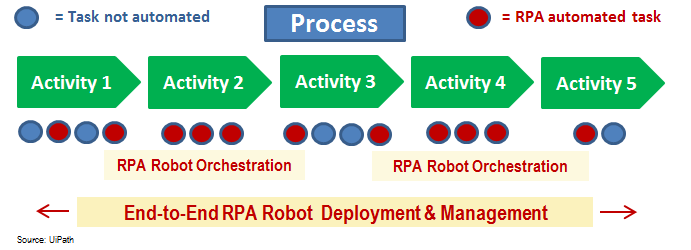Robotic Process Automation - Go Big or Go Home

Two thought-provoking articles were published on robotic process automation in the past week: David Poole from Symphony on the Future of Work and process innovation; Mihai Badita from UiPath, fea

tured in ProcessMakers Expert Interview Series. Each takes a different perspective on the technology but share a theme: RPA innovation is intensifying, adoption is accelerating and companies need to be both knowledgeable and proactive about robotic automation. As part of that common theme, both make a point which is critical for any company taking a serious look at this technology: Robotic process automation must be viewed in the context of the enterprise as a whole - and implemented accordingly - in order to reap full benefits.
But what about their shared view of an initial deployment based on “quick wins”: a pilot in David Poole’s parlance; a priority on simple processes by Mihai Badita? Could there other approaches to consider, ones with greater advantages?
Focus on the End Game
Both authors promote the philosophy that robotic automation adopters should focus on an enterprise level as the process automation end game. Mihai Badita says, “Software… should conform to global IT and security changes…..easy to implement….manage and scale.” David Poole states, “….real power and long term business case will not come from a series of tactical solutions. Real value will be Real value will be driven by taking a wider view and some decisions around the desired outcomes.”
What’s going on here is quite important. Both authors are saying that organizations should recognize the leading RPA vendors have left the limitations of desktop automation behind by innovating and elevating the technology to enterprise level automation.
Desktop automation lives at the workstation level and is what many people continue to visualize when they think of robotic technology. It enables a business user’s ownership of repetitive, rules-based, manual activities to be replaced by a robot in an independent, single instance of automation. The benefits of this automation can be significant – but limited by its individual user’s scope
On the other hand, enterprise automation moves beyond the desktop level of individual tasks to a much broader and larger scope of activities: sequential tasks linked by entrance and exit criteria. It can also extend beyond to processes – groups of sequential activities; again, linked by entrance and exit criteria. Even more significantly, enterprise automation enables organizations to orchestrate processes. As David Poole describes this, “Robots will pass work to other robots and other applications; queue up work for humans to perform when they are online….”

With enterprise automation and process orchestration as the end game, the focus must be on making those capabilities possible. Certainly the RPA product must be on a platform architected to enterprise standards; able to deploy and organize large numbers of robots with an intuitive management dashboard; capable of queuing work for robot pools with performance reporting and service level monitoring. The software capabilities should extend beyond presentation layer technologies and integrate well with Citrix (including Xen) and other virtualization technologies – plus significant enterprise applications such as SAP (GUI & Web); Oracle; Siebel, PeopleSoft, Salesforce.com, FIS and BMC Remedy.
Go Big
Going “Big” with RPA doesn’t refer to the technology investment, because the software costs are modest compared to ERP, CRM and BPM systems. Instead, it refers to the organizational investment: required automation skillsets and a managerial framework for automation planning, monitoring and associated accountability.
Skillsets: just as the emergence of enterprise automation significantly increased operational benefits, it also elevated skillset requirements.
Business analyst skillsets must be in place for two reasons: enterprise automation is dependent upon accurate documentation of current state processes, user actions and user decisions; orchestrated process requires a full understanding of upstream and downstream interdependencies and relationships.
IT skillsets are needed for enterprise infrastructure, development environments, automation of complex processes, end-to-end process orchestration scripts as well as major and minor automation enhancements.
Management skillsets are necessary for planning, deployment, monitoring and reporting of enterprise automation and process orchestration activities.
Governance resources available to administer and monitor: version control policies for automation scripts; change control methodologies around the automated processes; and server repository controls for archiving and data management.
Managerial framework: unless robotic automation is perceived and treated as fundamentally a change management project, it will be difficult to overcome customary organizational resistance and succeed.
A key step is to establish a metric such as VFTE (virtual full time employee) so that automation goals can be set, monitored and accountability enforced. A VFTE is a deployed robot and is represented on the organizational chart alongside customary FTEs. This allows management to see at a glance the organization’s robotics footprint at the business unit level.
Once this transparency is achieved, an automation project plan can be implemented, managed and revised as needed. Project reporting will enable senior management to have enterprise visibility for implementation milestones and performance levels.
Go Home
Unless the tactic of immediate quick wins is part of a “Go Big” roadmap, it’s very likely to be part of a “Go Home” eventuality. The reason is that a quick win is simply another name for a small, limited scope, automation project. Since it won’t resemble either enterprise level automation or process orchestration, it won’t validate either’s business case. A quick wins approach will not move the decision-making needle, but it could trigger counterproductive organizational alarm over a robot “invasion”.
What about a successful quick win project as proof of the RPA concept? To the contrary; using results from a small, cherry-picked project to prove this concept is better evidence management has the mindset to “Go Home” rather than “Go Big”.
Why? Because here simply isn’t any need for a SMB+ size company to look for such proof from a small, cherry-picked project – when much more impressive evidence is already visible in the BPO industry. During September of this year, 90% of surveyed BPO service providers surveyed by Mindfields said they were committed to investing in robotic automation technology.
These companies live and die by operational processes, and they are collectively pulling robotic software into their business models. This remarkable endorsement should be sufficient proof of concept for any progressive management team. Actually, it should be increasingly clear to every management team the biggest risk is “Going Home” when your competition is “Going Big.”

Strategic Advisor, Tquila Automation
Get articles from automation experts in your inbox
SubscribeGet articles from automation experts in your inbox
Sign up today and we'll email you the newest articles every week.
Thank you for subscribing!
Thank you for subscribing! Each week, we'll send the best automation blog posts straight to your inbox.



